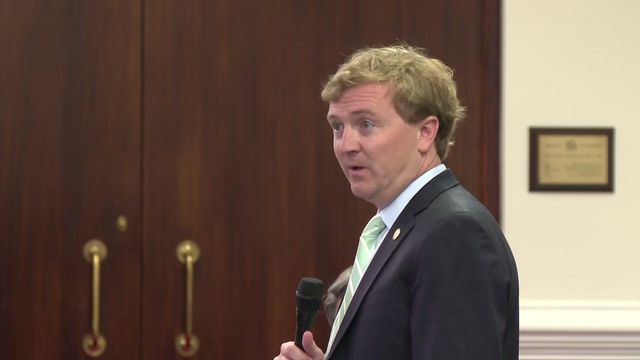NC education leaders want to pilot teacher licensure overhaul before statewide expansion

The North Carolina State Board of Education plans to consider asking lawmakers to permit and fund a pilot program for teacher licensure that would boost teacher pay and classroom support while subjecting teachers to more consequential evaluations.
It’s a smaller-scale plan than had been discussed for months, recommending a statewide overhaul of licensure all at once.
Board Member Jill Camnitz said Wednesday the board will take up the recommendation of one of its subcommittees to pursue licensure changes in just a few school districts first. A vote will take place at the board’s meeting Thursday, when it will also approve a generic blueprint for the licensure changes but not the details of what those changes would be. The subcommittee recommended the blueprint on just a 9-7 vote Nov. 10.
The board’s attorney would research what laws and policies must change to allow the pilot program to proceed and report back in January. The North Carolina General Assembly would need to permit any pilot program in law and approve funding.
State leaders are proposing the changes in an effort to improve teacher recruitment and retention.
Funding for the overhaul statewide, as drafted, would top $1 billion annually. A pilot program would cost much less, though how many and which districts would participate remains to be seen.
As drafted, the proposed overhaul of the state’s teacher licensure system would, for the first time, tie a teacher’s pay to the license the teacher holds and then provide raises each year. Starting pay would be higher than it is currently; pay for most teachers would top $56,000 — $2,000 more than the current maximum pay. It would also provide additional teaching staff to serve as leaders and mentors for other teachers. Each teacher would face a performance review in part or in whole based on student test scores that would determine whether the teacher can keep their license.
The proposed licensure system would be unique nationally.
State leaders contend the plan would ensure more student success by providing teachers with more support and more rigorous evaluation. They say it would also be friendly to teachers who enter the profession from another profession and who don’t have degrees in education.
“Our singular focus is improving academic achievement. … We’re facing the reality that our current system is not supporting our teachers well enough,” Board Chairman Eric Davis said during Wednesday’s board meeting.
Critics of the proposal argue the face that the state has not selected evaluation methods for most teachers means the proposal isn’t ready to move forward. They note teachers already are already subject to evaluation and can be placed on improvement plans or terminated for poor performance. They also raise questions about whether the plan is feasible amid years of teacher shortages.
State Board of Education Member Olivia Oxendine asked about that Wednesday.
“This is intended in some way to address teacher shortages, Oxendine said. “How can we grow the profession at the same time we are eliminating them?”
Superintendent Catherine Truitt said an “off-ramp” for teachers who don’t meet expectations in their evaluations is no longer part of the plan. What would happen to teachers who don’t meet expectations would need to be fleshed out by the board’s subcommittee recommending the changes, the Professional Educator Preparation and Standards Committee.
In the current draft, entry-level teachers who did not meet or exceed expectations would be unable to move to a higher or license. Entry-level licenses would not be renewable. Teachers who had a full teaching license would not be able to renew it.
Under the way the state currently evaluates teachers, using the N.C. Educator Effectiveness System, just 43 teachers fall into the “needs improvement” category, according to a presentation Nov. 10 from Tom Tomberlin, the state Department of Public Instruction's senior director of educator preparation and licensure. That’s less than 1% of teachers. However, the current draft licensure plan would not use this system, which is a collection of measures; teachers could only use one measure.
For the 40% of teachers who are also subject to the Education Value-Added Assessment System — meaning teachers whose students take the state’s standardized tests — about 7% would fall into the “needs improvement” category. Those same teachers could elect to use another effectiveness measure, if they suspected they would fare better.
State Teacher of the Year and board advisor Leah Carper said some teachers are concerned state lawmakers would choose to implement only part of the licensure overhaul. For instance, they could approve subjecting teachers to more consequential evaluations but not raising pay or increasing teacher support.
“There is no guarantee,” Davis said. But the board’s strategy of pursuing a pilot program that mirrors the current draft — and adjusting any proposed statewide overhaul based on the results — could make a better argument for lawmakers not to pick elements of the overhaul piecemeal, he said.
“That will create a much stronger argument … (and) win the day nine times out of 10, which we also want to deliver to our teachers,” Davis said.
What happens next
A pilot program, if approved by the board and by lawmakers this spring, would last a few years. It’s unclear when it would begin.
The Professional Educator Preparation and Standards Committee would need to report to the board by March on how teachers should be evaluated and other rules that would need to be established before a pilot program could begin.
The state General Assembly begins meeting in January for its long session, which has no end date.
The Professional Educator Preparation and Standards Committee, by the state law that created it in 2017, is charged with making recommendations on teacher licensure, not the State Board of Education, which can only ask lawmakers change licensure statutes.
While the law states the committee is supposed to develop the licensure system, the committee has largely revised a model given to them from what state officials have argued was a non-public group called the Human Capital Roundtable, facilitated by the publicly funded Southern Regional Education Board using funds from the Gates Foundation. The roundtable was comprised Department of Public Instruction employees, State Board of Education Member Jill Camnitz and other education leaders in the state. The system mirrors one the Southern Regional Board of Education proposed for Mississippi before the group proposed a system for North Carolina. Mississippi has not adopted the system.
The salary impact for teachers
Currently, teachers are paid based on the number of years of experience they have, beginning at $37,000. They must have a bachelor’s degree.
Under the draft, they would be paid anywhere from $38,000 to $45,000 in the first year, so long as they had a bachelor’s degree, depending on which entry-level license they qualified for. The draft would also allow for a limited number of apprentice teachers, which could be student teachers, to earn $30,000. Those teachers, who would not have a bachelor’s degree, would lead classroom activities but that would be supplemented in part by a designated teacher leader at the school, who would also be the classroom’s official teacher.
Teachers could achieve a full teaching license once they prove they are effective — using elevation methods yet to be identified — for at least three of their most recent five years of teaching. Teachers may take about three to six years of teaching to reach that license. Starting pay at that level would be $56,000 — more than $10,000 above current pay for that experience level — with a pay raise each year. Once the license is renewed, every five years, the teacher would receive an additional pay bump, followed by more annual increases.










